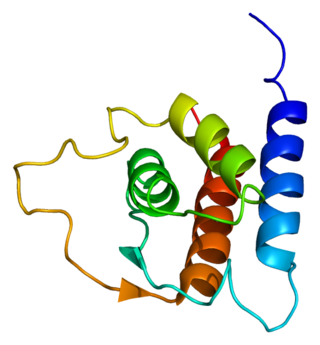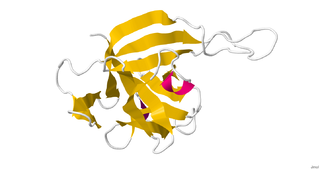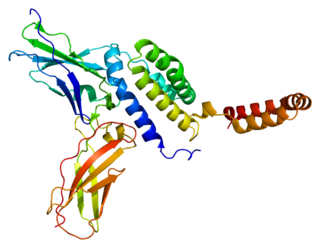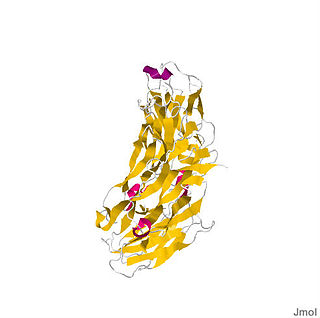Interleukin 1 receptor-like 1, also known as IL1RL1 and ST2, is a protein that in humans is encoded by the IL1RL1 gene. [5] [6] [7]
Interleukin 1 receptor-like 1, also known as IL1RL1 and ST2, is a protein that in humans is encoded by the IL1RL1 gene. [5] [6] [7]
IL1RL1 is a member of the Toll-like receptor superfamily based on the function of its intracellular TIR domain, but its extracellular region is composed of immunoglobulin domains. Unlike other members of the family IL1RL1 does not induce an inflammatory response through activation of NF-κB, although it does activate MAP kinases. [8]
ST2 is a member of the interleukin 1 receptor family. The ST2 protein has two isoforms and is directly implicated in the progression of cardiac disease: a soluble form (referred to as soluble ST2 or sST2) and a membrane-bound receptor form (referred to as the ST2 receptor or ST2L). When the myocardium is stretched, the ST2 gene is upregulated, increasing the concentration of circulating soluble ST2. [9] The ligand for ST2 is the cytokine Interleukin-33 (IL-33). Binding of IL-33 to the ST2 receptor, in response to cardiac disease or injury, such as an ischemic event, elicits a cardioprotective effect resulting in preserved cardiac function. This cardioprotective IL-33 signal is counterbalanced by the level of soluble ST2, which binds IL-33 and makes it unavailable to the ST2 receptor for cardioprotective signaling. As a result, the heart is subjected to greater stress in the presence of high levels of soluble ST2.
The gene is found on the long arm of chromosome 2 (2q12). It is 40,536 bases long and is located on the Watson (plus) strand. It encodes a protein of 556 amino acids (molecular weight 63,358 Da). Both membrane bound and soluble forms are known. The protein is known to interact with MyD88, IRAK1, IRAK4 and TRAF6. It appears to be essential for the normal function of T helper cells type 2 (Th2 cells) .
Alarmin IL-33 is constitutively expressed as a nuclear protein in all epithelial and endothelial cells, but also in secondary lymphoid organs. The biological and immunological function of this cytokine is mainly used in intestines, skin or lung epithelial tissues. [10] Human keratinocytes are expressing this protein just after IFNg stimulation. [11] Releasing of this cytokine is associated with necrosis or mechanical damage of epithelial or endothelial tissues caused by injury or inflammation. In contrast to related IL-1 cytokines, Il-33 does not need any enzymatic cleavage for activation and its function.
Two isoforms of ST2 were described in mammals. The membrane-bound ST2, which provides the activation pathway and soluble ST2 that originates from another promoter region of the il1rl1 gene and lacks the transmembrane and cytoplasmic domains. [12] Interestingly, all the members of the IL-1 family such as receptor share a common intracellular Toll/IL-1 receptor (TIR) domain. IL-33 binds specifically to ST2, which in association with IL1RAcP to form a heterodimeric receptor and TIR domain dimerization together with MyD88 leads to activation of TRAF6. This signal transduction is not crucial. Activation of cell effector mechanisms trough IL-33/ST2 is present also in TRAF6 deficient mice. [13]
Even though under IL-33 and IL-1 alarmins relationship, they have different aim to effector function of T regulatory cells. It was shown, that regulatory T cells deficient in IL-1 receptor (IL-1R) have more effective suppression capacity and phenotype stability. It shows, that IL-1 alarmins have an inhibition effect to Tregs. [14]
There is clear correlation between T regulatory cell ST2 and Th2 specific transcription factor GATA3 expressions. Both molecules are present in T regulatory cells together. GATA3 transcription factor has been shown to promote ST2 gene expression by binding to an enhancer element of foxp3 gene. Foxp3 transcription factor is necessary for T regulatory cell phenotype stability and suppression function mainly based on gene silence effect. It was also shown, that after different cytokine IL-23 stimulation which leads to activation of STAT3, the suppressive effect of Tregs is decreased together with ST2 and Foxp3 expression. It looks, that GATA3 with presence of STAT3 has different preferences in gene expression regulation. [15] This observation suggest longterm theory about crucial role on antagonistic aims of IL-33 and IL-23 to mucosal immunity and in their productions are able to cause IBDs. [15]
In ST2+ T Regulatory cell is present soluble form of ST2 without transmembrane and cytosolic domain. After IL-33 signalization through membrane ST2 in Tregs indicates expression of both membrane and soluble isoforms. Releasing of soluble ST2 into extracellular space cause neutralization of IL-33 and regulation of inflammation. [16]
It is well known, that high presence of T regulatory cells in cancer immune reaction do not mean good prognosis for oncologic patients. It was observed, that depletion of ST2 or IL-33 in colon or intestine cancer makes higher development of Th1 immune reaction with presence of CD8+ cytotoxic T cells, which are the most efficient in cancer treatment. [17]
Mutations in this gene have been linked to atopic dermatitis and asthma.
The protein encoded by this gene serves as a cardiac biomarker.

The interleukin 4 is a cytokine that induces differentiation of naive helper T cells (Th0 cells) to Th2 cells. Upon activation by IL-4, Th2 cells subsequently produce additional IL-4 in a positive feedback loop. IL-4 is produced primarily by mast cells, Th2 cells, eosinophils and basophils. It is closely related and has functions similar to IL-13.

Amphiregulin, also known as AREG, is a protein synthesized as a transmembrane glycoprotein with 252 aminoacids and it is encoded by the AREG gene. in humans.
Interleukin 5 (IL-5) is an interleukin produced by type-2 T helper cells and mast cells.

Interleukin 13 (IL-13) is a protein that in humans is encoded by the IL13 gene. IL-13 was first cloned in 1993 and is located on chromosome 5q31.1 with a length of 1.4kb. It has a mass of 13 kDa and folds into 4 alpha helical bundles. The secondary structural features of IL-13 are similar to that of Interleukin 4 (IL-4); however it only has 25% sequence identity to IL-4 and is capable of IL-4 independent signaling. IL-13 is a cytokine secreted by T helper type 2 (Th2) cells, CD4 cells, natural killer T cell, mast cells, basophils, eosinophils and nuocytes. Interleukin-13 is a central regulator in IgE synthesis, goblet cell hyperplasia, mucus hypersecretion, airway hyperresponsiveness, fibrosis and chitinase up-regulation. It is a mediator of allergic inflammation and different diseases including asthma.

Interleukin-18 (IL-18), also known as interferon-gamma inducing factor is a protein which in humans is encoded by the IL18 gene. The protein encoded by this gene is a proinflammatory cytokine. Many cell types, both hematopoietic cells and non-hematopoietic cells, have the potential to produce IL-18. It was first described in 1989 as a factor that induced interferon-γ (IFN-γ) production in mouse spleen cells. Originally, IL-18 production was recognized in Kupffer cells, and liver-resident macrophages. However, IL-18 is constitutively expressed in non-hematopoietic cells, such as intestinal epithelial cells, keratinocytes, and endothelial cells. IL-18 can modulate both innate and adaptive immunity and its dysregulation can cause autoimmune or inflammatory diseases.

Interleukin 21 (IL-21) is a protein that in humans is encoded by the IL21 gene.

Interleukin 33 (IL-33) is a protein that in humans is encoded by the IL33 gene.

Interleukin-26 (IL-26) is a protein that in humans is encoded by the IL26 gene.

Interleukin 24 (IL-24) is a protein in the interleukin family, a type of cytokine signaling molecule in the immune system. In humans, this protein is encoded by the IL24 gene.

Interleukin 19 (IL-19) is an immunosuppressive protein that belongs to the IL-10 cytokine subfamily.

Signal transducer and activator of transcription 6 (STAT6) is a transcription factor that belongs to the Signal Transducer and Activator of Transcription (STAT) family of proteins. The proteins of STAT family transmit signals from a receptor complex to the nucleus and activate gene expression. Similarly as other STAT family proteins, STAT6 is also activated by growth factors and cytokines. STAT6 is mainly activated by cytokines interleukin-4 and interleukin-13.

The interleukin 4 receptor is a type I cytokine receptor. It is a heterodimer, that is, composed of two subunits. IL4R is the human gene coding for IL-4Rα, the subunit which combines with either common gamma chain or with IL-13Rα1.

Interleukin 1 receptor, type II (IL-1R2) also known as CD121b is an interleukin receptor. IL1R2 also denotes its human gene.

Interleukin-10 receptor subunit alpha is a subunit for the interleukin-10 receptor. IL10RA is its human gene.

Interleukin 1 receptor, type I (IL1R1) also known as CD121a, is an interleukin receptor. IL1R1 also denotes its human gene.

Interleukin-1 receptor-like 2 is a protein that in humans is encoded by the IL1RL2 gene.

The interleukin-18 receptor 1 (IL-18R1) is an interleukin receptor of the immunoglobulin superfamily. IL18R1 is its human gene. IL18R1 is also known as CDw218a.

The Interleukin-2 receptor alpha chain is a protein involved in the assembly of the high-affinity Interleukin-2 receptor, consisting of alpha (IL2RA), beta (IL2RB) and the common gamma chain (IL2RG). As the name indicates, this receptor interacts with Interleukin-2, a pleiotropic cytokine which plays an important role in immune homeostasis.

Interleukin-17 receptor (IL-17R) is a cytokine receptor which belongs to new subfamily of receptors binding proinflammatory cytokine interleukin 17A, a member of IL-17 family ligands produced by T helper 17 cells (Th17). IL-17R family consists of 5 members: IL-17RA, IL-17RB, IL-17RC, IL-17RD and IL-17RE. Functional IL-17R is a transmembrane receptor complex usually consisting of one IL-17RA, which is a founding member of the family, and second other family subunit, thus forming heteromeric receptor binding different ligands. IL-17A, a founding member of IL-17 ligand family binds to heteromeric IL-17RA/RC receptor complex. IL-17RB binds preferentially IL-17B and IL-17E and heteromeric IL-17RA/RE complex binds IL-17C. However, there is still unknown ligand for IL-17RD. The first identified member IL-17RA is located on human chromosome 22, whereas other subunits IL-17RB to IL-17RD are encoded within human chromosome 3.

The Interleukin-1 family is a group of 11 cytokines that plays a central role in the regulation of immune and inflammatory responses to infections or sterile insults.